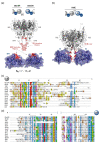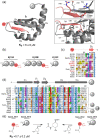Docking domain-mediated subunit interactions in natural product megasynth(et)ases
- PMID: 33640957
- PMCID: PMC9113145
- DOI: 10.1093/jimb/kuab018
Docking domain-mediated subunit interactions in natural product megasynth(et)ases
Abstract
Polyketide synthase (PKS) and non-ribosomal peptide synthetase (NRPS) multienzymes produce numerous high value metabolites. The protein subunits which constitute these megasynth(et)ases must undergo ordered self-assembly to ensure correct organisation of catalytic domains for the biosynthesis of a given natural product. Short amino acid regions at the N- and C-termini of each subunit, termed docking domains (DDs), often occur in complementary pairs, which interact to facilitate substrate transfer and maintain pathway fidelity. This review details all structurally characterised examples of NRPS and PKS DDs to date and summarises efforts to utilise DDs for the engineering of biosynthetic pathways.
Keywords: Biosynthesis; Non-ribosomal peptide synthetase; Polyketide synthase.
© The Author(s) 2021. Published by Oxford University Press on behalf of Society of Industrial Microbiology and Biotechnology.
Figures










Similar articles
-
Structural basis for chain release from the enacyloxin polyketide synthase.Nat Chem. 2019 Oct;11(10):913-923. doi: 10.1038/s41557-019-0335-5. Epub 2019 Sep 23. Nat Chem. 2019. PMID: 31548674 Free PMC article.
-
Molecular diversity sculpted by fungal PKS-NRPS hybrids.Chembiochem. 2013 Jan 2;14(1):28-42. doi: 10.1002/cbic.201200624. Epub 2012 Dec 7. Chembiochem. 2013. PMID: 23225733 Review.
-
In silico analysis of methyltransferase domains involved in biosynthesis of secondary metabolites.BMC Bioinformatics. 2008 Oct 25;9:454. doi: 10.1186/1471-2105-9-454. BMC Bioinformatics. 2008. PMID: 18950525 Free PMC article.
-
Methylation-dependent acyl transfer between polyketide synthase and nonribosomal peptide synthetase modules in fungal natural product biosynthesis.Org Lett. 2014 Dec 19;16(24):6390-3. doi: 10.1021/ol503179v. Epub 2014 Dec 10. Org Lett. 2014. PMID: 25494235 Free PMC article.
-
Protein-protein interactions in polyketide synthase-nonribosomal peptide synthetase hybrid assembly lines.Nat Prod Rep. 2018 Nov 14;35(11):1185-1209. doi: 10.1039/c8np00022k. Nat Prod Rep. 2018. PMID: 30074030 Review.
Cited by
-
The inherent flexibility of type I non-ribosomal peptide synthetase multienzymes drives their catalytic activities.Open Biol. 2021 May;11(5):200386. doi: 10.1098/rsob.200386. Epub 2021 May 26. Open Biol. 2021. PMID: 34034506 Free PMC article. Review.
-
Enzymology of assembly line synthesis by modular polyketide synthases.Nat Chem Biol. 2023 Apr;19(4):401-415. doi: 10.1038/s41589-023-01277-7. Epub 2023 Mar 13. Nat Chem Biol. 2023. PMID: 36914860 Review.
-
Insights into azalomycin F assembly-line contribute to evolution-guided polyketide synthase engineering and identification of intermodular recognition.Nat Commun. 2023 Feb 4;14(1):612. doi: 10.1038/s41467-023-36213-9. Nat Commun. 2023. PMID: 36739290 Free PMC article.
-
Structure and Function of the α-Hydroxylation Bimodule of the Mupirocin Polyketide Synthase.Angew Chem Int Ed Engl. 2023 Nov 20;62(47):e202312514. doi: 10.1002/anie.202312514. Epub 2023 Oct 17. Angew Chem Int Ed Engl. 2023. PMID: 37768840 Free PMC article.
-
Protein-Protein Recognition Involved in the Intermodular Transacylation Reaction in Modular Polyketide Synthase in the Biosynthesis of Vicenistatin.Chembiochem. 2022 Jul 19;23(14):e202200200. doi: 10.1002/cbic.202200200. Epub 2022 May 16. Chembiochem. 2022. PMID: 35501288 Free PMC article.
References
-
- Aparicio J. F., Molnár I., Schwecke T., König A., Haydock S. F., Ee Khaw L., Staunton J., Leadlay P. F. (1996). Organization of the biosynthetic gene cluster for rapamycin in Streptomyces hygroscopicus: Analysis of the enzymatic domains in the modular polyketide synthase. Gene, 169(1), 9–16. https://doi.org/10.1016/0378-1119(95)00800-4. - PubMed
-
- Bretschneider T., Heim J. B., Heine D., Winkler R., Busch B., Kusebauch B., Stehle T., Zocher G., Hertweck C. (2013). Vinylogous chain branching catalysed by a dedicated polyketide synthase module. Nature, 502(7469), 124–128. https://doi.org/10.1038/nature12588. - PubMed
-
- Broadhurst R. W., Nietlispach D., Wheatcroft M. P., Leadlay P. F., Weissman K. J. (2003). The structure of docking domains in modular polyketide synthases. Chemistry & Biology, 10(8), 723–731. https://doi.org/10.1016/s1074-5521(03)00156-x. - PubMed
-
- Buchholz T. J., Geders T. W., Bartley F. E., Reynolds K. A., Smith J. L., Sherman D. H. (2009). Structural basis for binding specificity between subclasses of modular polyketide synthase docking domains. ACS Chemical Biology, 4(1), 41–52. https://doi.org/10.1021/cb8002607. - PMC - PubMed
-
- Cai X., Zhao L., Bode H. B. (2019). Reprogramming promiscuous nonribosomal peptide synthetases for production of specific peptides. Organic Letters, 21(7), 2116–2120. https://doi.org/10.1021/acs.orglett.9b00395. - PubMed
Publication types
MeSH terms
Substances
Grants and funding
LinkOut - more resources
Full Text Sources
Other Literature Sources
Miscellaneous

